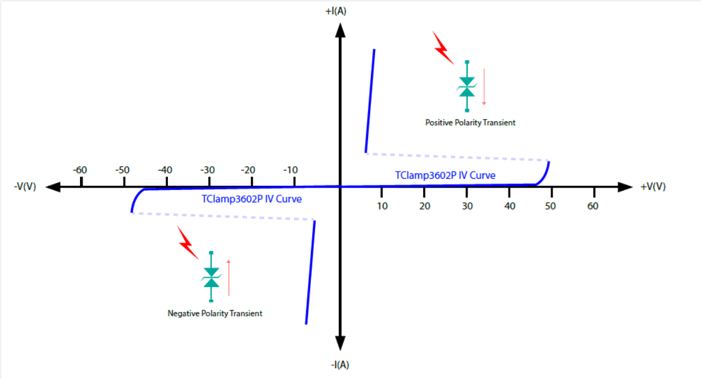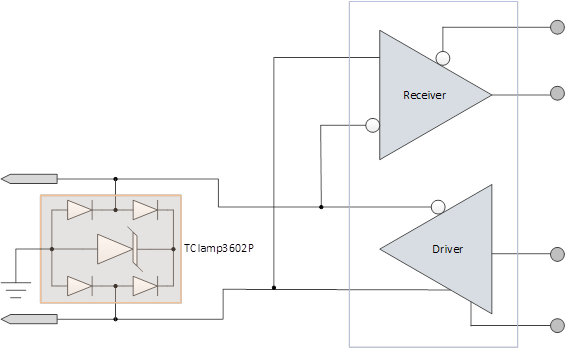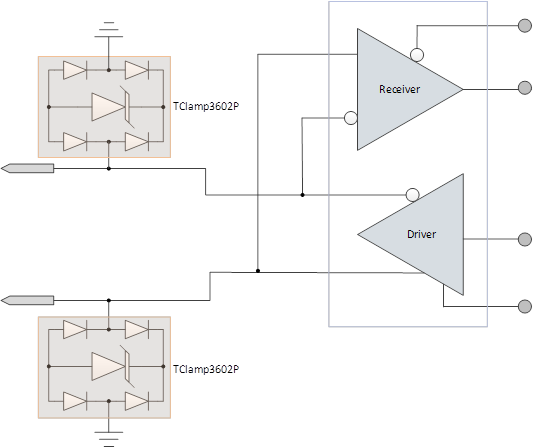Modern industrial networks rely on robust RS-485 communication links for long distance data transmission. These networks operate in harsh electromagnetic environments and must be capable of withstanding electrical overstress (EOS) events without damage. Semtech’s Protection Products Group application engineering team recently had the opportunity to work with Renesas Corporation engineers on a reference design for protecting Renesas’ fault-protected RS-485 transceivers, used in industrial applications.

EOS Threats in RS-485 Networks
There are two primary types of EOS threats in industrial RS-485 networks. The first is due to the physical installation. It is common for industrial DC supply voltages to be distributed through the same conduits as an RS-485 network. Short circuits between the supply and data conductors can occur due to faulty wiring and insulation breaks. Renesas’ overvoltage protected transceivers have bus terminals with high standoff voltage capabilities, designed to survive the aforementioned short circuit events. The second type of threat is due to transient overvoltages that occur because of EFT, ESD and lightning induced surges. For this type of threat, an external protection device is required. Transient Voltage Suppressor (TVS) diodes are preferred due to fast response time and low clamping voltage as compared to other protection technologies.
TVS Diode Selection Parameters
Semtech’s TClamp®3602P provided an ideal solution. When selecting TClamp3602P, there were a few factors to consider. First, the working voltage had to be higher than the common-mode voltage range (CMVR) of the RS-485 transceiver. In this case, the transceivers in question have a CMVR of +/-25V for use on industrial DC buses. These buses have a nominal 24V operating voltage, but have voltage excursions as high as 36V. TClamp3602P has a working voltage of 36V with a minimum breakdown voltage of 40V, so it will not trigger under normal operating conditions, even at worst case industrial DC bus voltages. Second, the TVS capacitance should be low enough as to not adversely affect signal transmission. TClamp3602P is designed with an internal array of steering diodes to reduce the overall capacitance to 4pF maximum. This device can be used in long-haul networks or high-speed (40Mbps) point-to-point data links. Finally, the trigger and TLP clamping voltages should be below the transceiver’s internal protection circuitry to avoid damage during surge events. TLP analysis of the Renesas transceivers showed the internal protection structures to have a trigger voltage greater than 70V. The main TVS die in TClamp3602P triggers between 40–50V ensuring it will trigger before the transceiver structures (Figure 1). The deep snap-back characteristic minimizes the stress on the protected transceiver.

Figure 1 – Tclamp3602P IV Characteristic Curve © Semtech Corporation 2020
Testing Design Configurations
Two design configurations were tested in Semtech’s applications lab. In the first design, one TClamp3602P was used to protect two data lines (Figure 2). While the component count is reduced, this configuration has the disadvantage of limiting the common-mode range of the transceiver. Using two TClamp3602P chips, one for each data line (Figure 3), enables utilization of the full common-mode range of the transceiver and provides superior symmetrical clamping characteristics. Each configuration was tested to IEC 61000-4-2 (ESD), IEC 61000-4-4 (EFT) and IEC 61000-4-5 (Surge). Both configurations passed ESD +/- 25kV ESD contact discharge and +/-30kV ESD air discharge per IEC61000-4-2, and +/- 2kV EFT per IEC61000-4-4. For surge, the single TVS configuration passed 1.75kV (tp= 1.2/50us) per IEC61000-4-5, while the configuration with two TClamp3602P chips passed +/-3.0kV under the same test conditions.

Figure 2 – Asymmetrical Clamping Solution with Partial Common-Mode Range © Semtech Corporation 2020
Figure 3 – Symmetrical Clamping Solution with Full Common-Mode Range © Semtech Corporation 2020
The test results confirm that the combination of TClamp3602P and Renesas’ overvoltage protected transceivers provide designers with an easily implemented, robust solution in RS-485 applications.
A detailed application note is available from Renesas.
Learn more about Semtech’s TClamp3602P for RS-485 protection.

Semtech, the Semtech logo and TClamp are registered trademarks or services marks of Semtech Corporation or its affiliates.




